WiHM 2023: From Scream Queen to Lady Badass: An Evolution of Women in Horror
From Scream Queen to Lady Badass: An Evolution of Women in Horror
by: Ray Van Horn, Jr.
Is there anything more cringeworthy in the horror genre than the unfashionable damsel in distress trope? It’s a hard sway from today’s horror scene, which has at least given actresses a 50/50 chance of being cast as sexpot butcher bait or given a more motivating assignment of kicking evil’s ass. Or in the contemporary cases of Toni Collette in Hereditary or Lupita Nyong’o in Us, redefining what women can do to the genre, much less for it.
As long as Betty Crocker and Hoover appliances were bleakly tagged upon the kitchen-bound stereotypes of women in pop culture, devaluation of females in horror was likewise an interminable norm. Let’s face the facts; horror films of yesteryear were seldom rewarding to their leading ladies, especially being outnumbered for work 3 to 1 by the men.
Bad enough those women lucky enough to be cast into a protagonist position in 1950s and later, Eighties horror, were often disposable eye candy. Females of the drive-in days of the Fabulous Fifties were scripted to divvy just enough common-sense motherly dialogue to ferry the B-level masculine drivel overruling them. This, as muscleheads in rubber suits, werewolves the palest shade of Lon Chaney, Jr. and stop-motion clay monsters sent women of the Fifties into extreme closeup mode, shrieking their guts out. Frozen in place for seconds until they were either rescued by alpha intervention or they disappeared from the story altogether offscreen. In either scenario, done so without a fight. You just know the ancient warrior goddesses Sekhmet, Hel, Athena and Freya were face-palming themselves at the hapless (and hopeless) sight of these pin curled, Victory rolled “scream queens.”
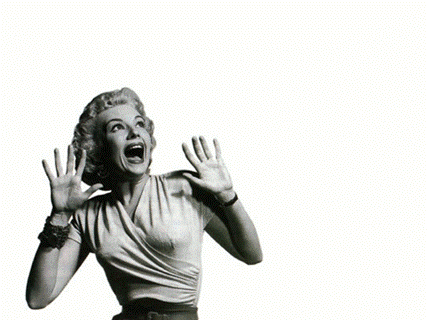
You can catch a plethora of black and white horror nuggets on your own or to the tune of Svengoolie’s loveable cornball drag. For those who grew up watching Universal monster flicks and the 1950s atomic age romps via their local ghost host emcees on late Saturday nights, Sven (aka Rich Koz) is a horror hound’s security blanket. Those monochromatic oldies but goodies he peddles from the Fifties through the early Sixties remain timid by today’s extreme standards. Yet the bigger offense lurking from those often-gaudy terrors from the beyond lies more in the way women who weren’t Barbara Steele or Beverly Garland were portrayed.
From that golden age of nuclear-fused lizards, ten story arachnoid, gelatinous daubs of doom, wetland creatures and bulbous-eyed aliens spewed the brainless stereotype of women-in-peril. Even if a female lead of 1950s horror was given a quasi-glamorous occupation such as laboratory assistant, naval yeoman or, heaven forbid, a department manager, chances are, she would be there to offer her two cents, only to be shot down instead of offered a rifle (much less trained to use one) to help the boys in one of their suicide missions.
As long as scream queens of the Fifties could screech louder than Little Richard and torch the screen with more conflagration than a McCarthy-ist burning of old EC Tales From the Crypt comics, this was all of which was required of women in horror. This, along with a random appearance pushing an Electrolux vacuum in a full dress and high heels during commercial breaks for Ed Sullivan and Milton Berle.

It’s no wonder a young Patty McCormack in the titular The Bad Seed from 1956 shook the world she lived in as an unforgettable, horrific little badass of her time. Far more insidious than easily irritable Bill Mumy from the “It’s a Good Life” episode from The Twilight Zone. McCormack’s glaring eyes of silent condemnation and her manipulative wares were a low-key but unnerving announcement of a new order slow to come. McCormack represents one of the early-on female horror survivalists.
If you want to really stretch the truth, we can go back as far as 1939’s The Wizard of Oz to pinpoint one of horror’s first female survivalists. Think about it. I mean, sure, Oz is a G-rated family classic, so much it used to run faithfully every year on network t.v. on Thanksgiving night. Yeah, the flying monkeys were scary enough to any twerp born before 1990. The same with those jerkface trees pelting our yellow brick-skipping heroes with apples. The freaking Wicked Witch of the West, though…man was she so sinister, we took feral delight in Dorothy’s dispatching her with a bucket of water. All to help her newfound, combusted friend made of straw. It was an act of courage not even the quivering lion had inside of him at that decisive moment heroes are born. Pin the medal on Judy Garland instead.
Boop-oop-a-doop? Oh, hell no. Betty may have had cartoon perverts to fend off, but she never had had to turn tables, much less escape a subterranean death circus from cannibalizing, brain-sledging chainsaw freaks like Caroline Williams did.
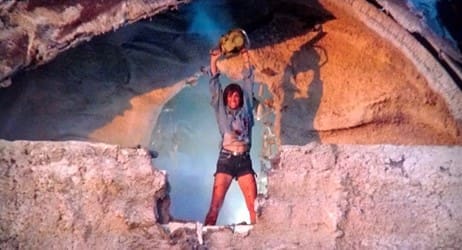
When we think about how far women have come in the entertainment realm, it’s action and horror where ladies have staked far more equality than any other movie genre, much less any other industry. Gal Gadot, Scarlet Johansson, Letitia Wright, Brie Larson, Eva Green and Margot Robbie have defined ultimate femme badassness in the comic book adaptation turf. The organizers of the Women’s Rights Movement are no doubt smiling from the other side. Yet I’m sure those in attendance on that fateful day on August 2, 1848 in Seneca Falls could never have foreseen the likes of Jamie Lee Curtis, Sigourney Weaver, Marilyn Burns, Danai Gurira, Adrienne King, Heather Langenkamp, Jessica Walter, Glenn Close, Essie Davis, Kyleigh Curran, Megumi Okina, Eihi Shiina, Shauna MacDonald, Caroline Williams, Camille Keaton, Sarah Butler, Neve Campbell, Millie Bobbie Brown, Milla Jovovich and many bold, badass ladies moving the horror genre forward in a pro-estrogen rebellion.
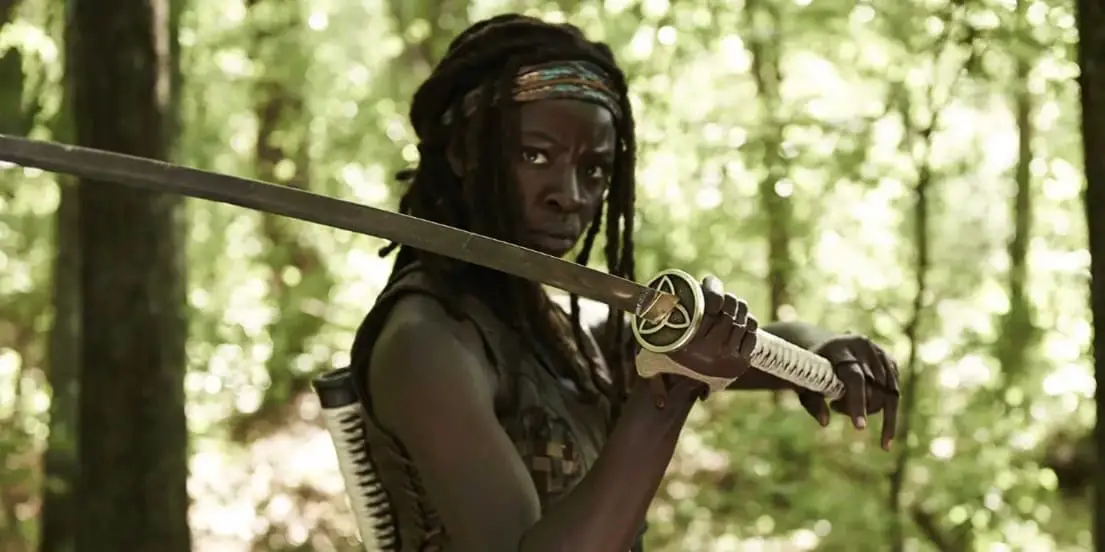
The theme of badass women of horror has become such a hot topic in the mainstream media everyone has their own Top 10 or 20 lists, most of the aforementioned filling their ranks. In this case, I’m talking about women of the genre who have either the natural skill set or the raw nerve to persevere through the ordeals of physical or psychological terror. This could be Michonne, Sasha, Maggie or Carol from The Walking Dead, which has prided itself, in comic book and television form, of depicting its women with a stoic resolve to dispatch both zombies and pissant human aggressors who get in their way of seeing the next sunrise. The Walking Dead as a show has become so mainstream its protagonists are as abundant and sadly throwaway as Game of Thrones, yet each show has more memorable, tough women to possibly give the late Rush Limbaugh reason to rue the day he first uttered “femi-Nazi.” For that matter, the topsy-turvy world of Stranger Things proves a woman’s worth standing in defiance against an otherworldly cataclysm, even those non-bioengineered girls deprived of the gift of telekinesis. While we’re at it, we can give the entire ensemble of The Chilling Adventures of Sabrina (the show and the dark Archie comic book it was bred upon) a huge nod for its women exhibiting even more moxy than its male leads.

We can wince in pain at the unnerving twittering of Asami Yamazaki’s (Eihi Shiina) methodic and excruciating piano wire torturing of Ryo Ishibashi in Audition, made worse knowing Yamazaki’s black widow act is simply how she gets by in life. We can roar in triumph at Suzy Bannon’s (Jessica Harper) sleuthing and exterminating of Madame Blanc’s ballet school of the occult in 1977’s redder than red prototype version of Suspiria. Take your pick who had the better outing in Cat People: Simone Simon in 1942 or Natasha Kinksi in the erotic remake forty years later. Both well ahead of their times.
Even though it doesn’t go well for her in the end, not a soul who’s ever watched the original Carrie would not cheer for her. Stephen King’s debut novel will always stand the test of time despite the famous legend of his wife, Tabitha, rescuing the manuscript from the trash before it became the timeless adolescent tragedy it is. Everyone enduring the high school experience, particularly those who were persecuted, not only wants Carrie White to triumph over her tormentors, but they welcome Carrie’s phoenix-like evolution into a walking Hell on Earth. She should’ve survived, fairness rules applying. Despite becoming a murderess, we wanted Carrie White to live, despite her volatile Catholic guilt dictating otherwise. Nobody playing her in the many adaptations of Carrie displayed both her fragility and fury better than Sissy Spacek in 1976. The same with her film mother, Piper Laurie, as the bible-thrashing Margaret White. Horror, much less film in general, had never seen the likes of either. Powerful performances of powerful women doomed to meet and die in each other’s arms at the gates of purgatory.
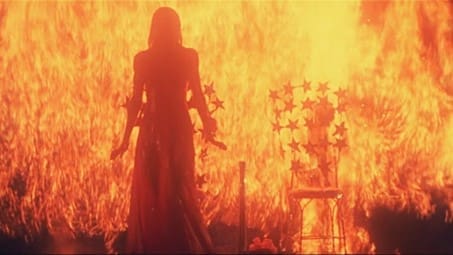
The transition in horror over the next couple decades from laughable shlock like The Crawling Eye to roles planting aggressive women at the forefront of the story like Repulsion, The Exorcist, Psycho, Rosemary’s Baby, Play Misty For Me, Eyes Without a Face and Whatever Happened to Baby Jane? showed women possess as dark as a side as any man, given provocation, wherewithal, stamina and/or supernatural elements guiding a chemical shakeup. It would take most of the 1980s to catch back up to this trailblazing thesis after one film both revolutionized the role of a woman as survivalist and, unfortunately, exploited the subversive titillation factor which the decade ran mad with: John Carpenter’s original Halloween.
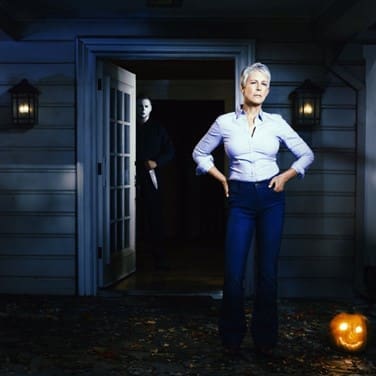
When we think of the quintessential female badass of horror, the de facto crown goes straight to Jamie Lee Curtis. An idol to many as a pillar of strength, Curtis is still today a statuesque frame of feminine perfection as the stock of Hollywood royalty (Tony Curtis and Janet Leigh). As horror’s top-reigning “scream queen,” we’ve enjoyed Jamie Lee’s comeuppance through the horror genre as the iconic foil to her pasty-face masked nemesis (and her one-time brother before the age of retcon), Michael Myers, in the Halloween series. Curtis also appeared in lesser-discussed horror pieces like Terror Train and the original versions of The Fog and Prom Night before heading toward comedy, drama and action films and later, as an author of children’s books. An unparalleled leader of women.
We all fell in love with Jamie Lee Curtis as extemporal babysitter Laurie Strode in her original run in 1978, where she was more on the lam in nerve-wracking pursuit by Myers. Yet it was that ironbound instinct inside of Laurie Strode which made us applaud her. Laurie Strode has already been on edge, convinced she’s being stalked through the first half hour of Halloween. When this manifests into its ugliest form, Strode’s early-on maternal instincts kick in to protect her elementary-aged charges in the face of sure slaughter. Down the road, an older Laurie Strode would have a satisfying return grudge match against Michael Myers in 1998’s Halloween: H20, only to go balls-out against him in 2018 in a wholly re-imagined Halloween which delivered the goods—even if its successors, Halloween Kills and Halloween Ends were insufferable wastes of Curtis’ talents. Give it to Curtis, though; all the Halloween movies she’s appeared in, nobody’s handed Michael Myers his sadistic ass more times, notwithstanding the inglorious Halloween: Resurrection.
While Halloween took the next step in horror evolution which Curtis’ own mother staked in 1960’s Psycho, the true dawn of the slasher film stepped out of the throttled safety zone of an idyllic suburbia and dropped with a creepy echo of ki ki ki…ma ma ma… into an equally tranquil summer camp via 1980’s Friday the 13th. Horror in the Eighties feasted on a rowdy diet of gore one-uppance, boob flashing, marijuana glorification and, of course, women largely existing to be chopped as objects of subjugated meat. Things have come a long way since Slumber Party Massacre. The Friday the 13th series, which was party time at the cinema for my generation, did redefine a woman’s place inside a slasher pic, albeit with caveats, which the original Scream righteously called shade upon.
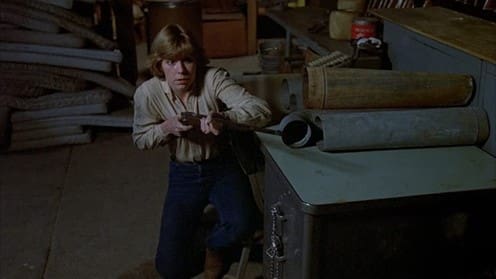
Adrienne King, Amy Steel, Dana Kimmell and later down the line, Lar Park Lincoln, were all survivors of their bloodthirsty attackers. None of them have sex inside their respective first, second, third and seventh films. I do issue further caveats that King dies in the beginning of Friday the 13th Part 2 (like this is a spoiler?) and it’s presumed Steel had off-camera sex with her boyfriend, Paul, while Kimmell testifies to a glorious love affair with her love interest, Rick, who instantly looks to have a return slip of the sausage upon their reunion in Part III. King tokes the ganja in the original Friday, but cutting slack to all of these ladies, each of them ran for their lives with the knife’s edge in their wake, yet all them delivered savage responses to their assaulters.
Only King gets the distinction of putting Mama Voorhees (the incomparable Betsy Palmer whom I had the joy of interviewing for Metal Maniacs magazine) down permanently. Should we give Palmer props for being one of the genre’s first serial killers? Absolutely, even if it’s gore maestro Tom Savini doing the stalking, laughing out loud. Though as Betsy told me and other interviewers, she did Friday the 13th strictly to get the money to a buy a new car to move forward in life. Pamela Voorhees unintentionally became bigger than her, and Betsy Palmer has already been a household name on Candid Camera, I’ve Got a Secret, Studio One in Hollywood and The Goodyear Playhouse. One of the few heralded women of 1950s entertainment.
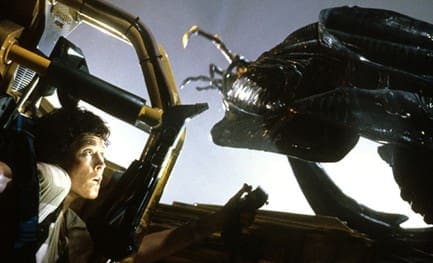
Sigourney Weaver showed the world what one woman left to fend for herself and a cat could do on a space freighter as huge as a Scottish castle, all of her shipmates mauled, in 1978’s Alien, one the most calamitous sci-fi/horror hybrids imagined. Weaver’s Lt. Ellen Ripley is one of the hallmarks of cinematic achievements for the advancement of women, even more so for her grunt-like manhandling of the ostensible xenomorphs in the gangbusters 1986 sequel, Aliens. Ripley became such a household name of feminine muscularity Aliens director James Cameron had no choice but to buff up his darling on-the-run Sarah Connor into a female survivalist who could stand tall in the cumbersome shadow of Arnold Schwarzenegger for the senses-raking Terminator 2: Judgment Day.
If you’re talking women who just wouldn’t take it anymore, there was Farrah Fawcett in the harrowing made-for-television retaliation piece The Burning Bed. Mother’s Day from 1980 was a sick yet appropriately gruesome revenge yarn in which two of three kidnapped women get vicious payback upon two horse-faced rapists and their appalling mother. The Drano down Ike’s throat bit remains one of the most rewarding moments of the decade’s kill scenes. Yet there are five words in the horror lexicon most fans think of when it comes to female-dished retribution.
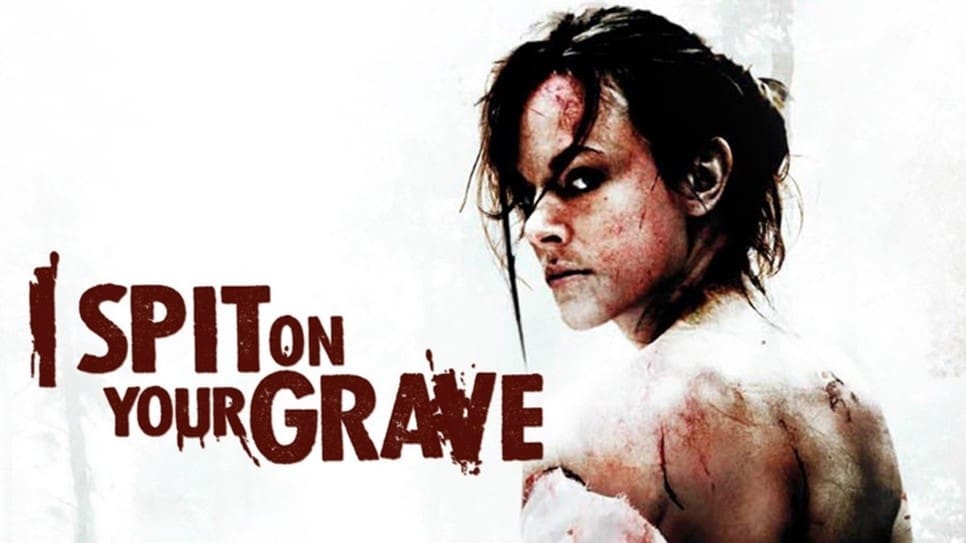
I Spit On Your Grave has turned from a cult exploitation film in 1978 to a torture porn phenomenon via its 2010 remake. Both Camille Keaton and Sarah Butler endured onscreen depravity beyond what any well-paid actress in Hollywood would accept. There’s suffering for your art, and there’s what these two ladies endured, spending a large chunk of their respective films’ running times naked in grueling, wooded conditions. Butler herself gave me a candid recount of what it took from her to shoot the Spit remake in an interview we did in 2010, hours after I received the screener for review. The payoff for Keaton and Butler’s brutalized characters presents some of the grisliest get-backs ever portrayed on film.
Gore geeks delight in Sarah Butler’s revenge, i.e. feeding one of her attackers his own castrated member and plugging the unscrupulous sheriff’s butt with his own shotgun. The original I Spit On Your Grave and its direct remake exists as warnings there are repercussions to sexual cruelty, in particular against women. The 2010 version has such a rabid fan base it makes “Films You Must See Before You Die” lists. Only the atrocities flung throughout Cannibal Holocaust and The Human Centipede provide more discomfiture.
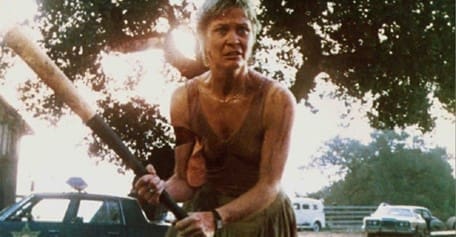
Stephen King, the master of the macabre, has given us a rich pantheon of horror heroes and villains for more nearly 50 years, and amongst his most memorable female survivalists would be Donna Trenton in Cujo (brought to vivid, tragic believability by Dee Wallace Stone in the movie adaptation), Beverly Marsh from It, even Wendy Torrance, who was far stronger in King’s novel than Shelley Duvall’s often cherished mousy interpretation. Rose the Hat and Abra Stone in Doctor Sleep are survivalists in their own way, though approaching their ideals and one another from opposite sides of the morality line. Then there’s Jessie Burlingame’s cuffed ordeal in the just-wrong Gerald’s Game. Let’s not forget the more recent “Gwendy” trilogy shared in writing between King and his trusted collaborator, Richard Chizmar. Gwendy has become a figurative pillar of strength throughout her narrative, having thrust upon her an enchanted button box filled with temptation and the means to end our entire world. Survival of the human race pending one woman’s scruple set put to a prolonged test.
We can talk about Heather Langenkamp, aka Nancy from the Nightmare On Elm Street movies as one of the genre’s definitive badass lady survivalists, since she’s gone dream-to-dream against the original knives-out badboy, Freddy Krueger three times along with appearances in Shocker, Home, Sub, Truth or Dare and Hellraiser: Judgment. Is there anything more satisfying in than watching Neve Campbell match wits against all of the Ghost Faces she’s had thrust upon her in the Scream flicks?
In the video game world, Lara Croft is recognized as the leading female badass for the Tomb Raider series, which may be more in the action realm, yet there are plenty of horror elements Croft faces down. Claire Redfield is perhaps video game’s CGI poster babe from the Resident Evil series, but never eff with her. The lady knows her way around weaponry as much as Ghost from Call of Duty. Ellie from The Last of Us games has evolved into a zombie-chewing grinder in her adult life and her character has pushed the envelope with her sexuality. Ellie is finding even greater life through HBO’s excellent new adaptation series. The gamers may hate on the televised version, but the horror fans are wonky for The Last of Us.
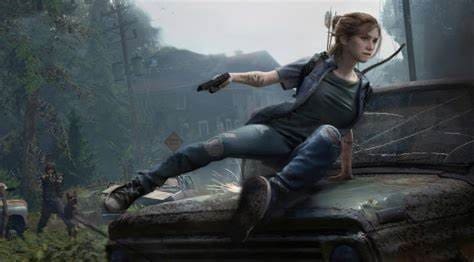
While ladies in horror comic books have long been demoted in much the same fashion as those ‘50s B movies, go back and dive into the EC horror classics like Tales From the Crypt, The Vault of Horror and The Haunt of Fear. The ladies may be lovesick saps at times, but more often than not, they’re just as, if even more conniving than the male antagonists. Revenge-driven stories are galore in those deliciously gross vignettes. Most of the horror hijinks are calculated by women, either for selfish gain or they’re just plain nuts; or on the flipside, they’re receiving justice keeper assistance from the grave.
If you’re a horror hound, the name Vampirella is second-to-none when it comes to vampirism lore. Yeah, she dashes around in thongs and that goofy collared sling barely keeping her top goodies shelved. Part of the sexual revolution of the 1970s in which she was born. Sleaze factor aside, Vampi is still a badass mama who’ll rip you apart, demon, vamp or fiend, and she’s in rowdy company with her monster maven cohorts, Pantha and Draculina. Vampi is now celebrating 50 years, the nonpareil survivalist of comic book nosferatu. Other longtime women haunting comics are Lady Death, Purgatori, Avengelyne, Jennifer Blood, Sara Pezzini, aka the Witchblade and of course, the imitable Goth goddess from The Sandman books, Death.
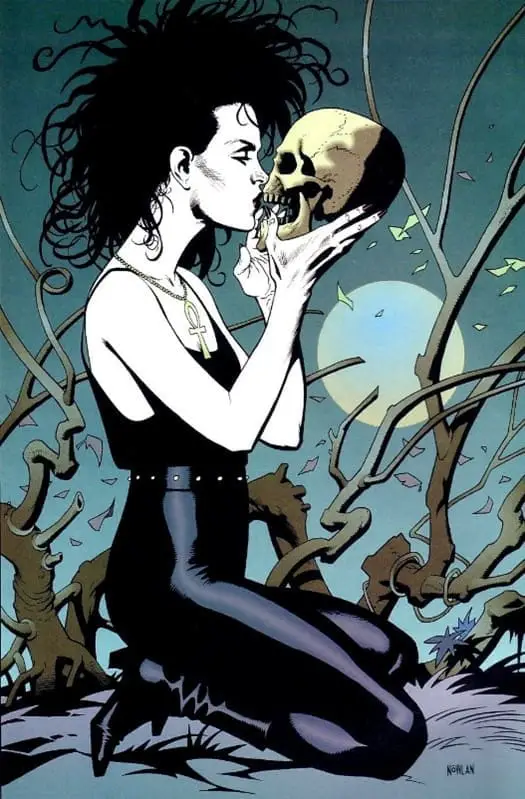
Perhaps one of the most memorable images in horror not yet mentioned is the final moments of The Descent, one of the greatest modern horror films along with Let Me In/Let The Right One In, It Follows, Hereditary, Get Out and Us. I sat there thunderstuck my first time watching The Descent once Sarah (Shauna MacDonald) finally escapes her spelunking trip gone disastrous. The story already set up with the calamity Sarah’s endured from the loss of her family in the beginning of the story, her bloody climb out of the caves with her friends lost to her, the sting of betrayal and those cave mutants in hot pursuit is exhausting. Especially if you’re claustrophobic and managed to make it all the way through the film. The way Sarah speeds away crying with David Julyan’s heartbreaking score whirling overtop her anguish…it’s one of the most humanistic scenes of shattered continued existence ever conceived.
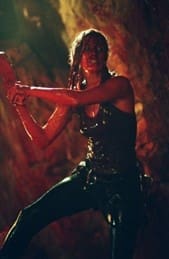
We’ve seen female lycanthrope shred their victims in The Howling movies and we’ve seen gals lay booby traps even John Rambo would geek over in You’re Next. Samara Weaving had the wool pulled over her eyes on her wedding night, but she served her new in-laws in the often hilarious Ready or Not. Danai Gurira is a beacon of strength for women, not only as Michonne Hawthorne, but also as Dora Milaje general Okoye in the Black Panther films. The ladies have finally found their voice in horror, and it’s not just a high-pitched falsetto to the tune of dark fate. Emily Blunt spoke volumes without having to use hers hardly at all in both A Quiet Place films. Naomi Harris’ handiwork with a machete in 28 Days Later? It sang a sanguinary tune that women in horror have become simply bad…ass…
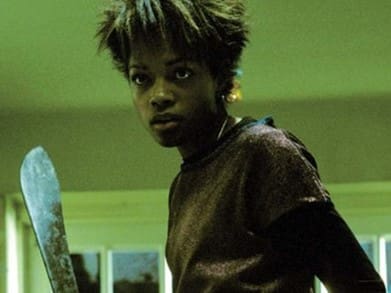
- About the Author
- Latest Posts














